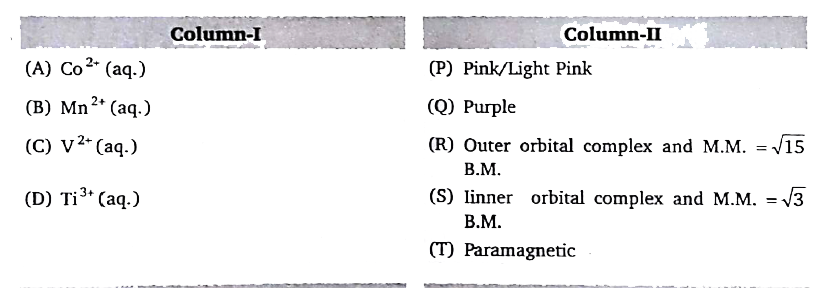Which of the following pairs show coordination isomerism?
[Co(NH3)6][Cr(CN)6]and[Cr(NH3)6][Co(CN)6]
[Co(NH3)3(H2O)2Cl]Br2and[Co(NH3)3(H2O)Cl⋅Br]Br⋅H2O
[Pt(NH3)4Cl2]Br2and[Pt(NH3)3B2]Cl2
[Co(NH3)3(CN)3][Co(NH3)3(CN)3]
The correct Answer is:A, D
To determine which pairs show coordination isomerism, we need to understand the definition of coordination isomers. Coordination isomers are compounds that have the same formula but differ in the distribution of ligands between the cationic and anionic parts of the compound.
Let's analyze the provided pairs step by step:
Step 1: Identify the Ligands and Central Metal Atoms
- For each pair, identify the ligands (molecules or ions that are coordinated to the central metal) and the central metal atoms.
Step 2: Check for Cationic and Anionic Species
- Determine if the compounds in each pair consist of both cationic and anionic species. Coordination isomerism requires the presence of both types of species.
Step 3: Analyze Ligand Distribution
- For the pairs that have both cationic and anionic species, check if the ligands are distributed differently between the cationic and anionic parts.
Step 4: Conclusion
- Based on the analysis, conclude which pairs exhibit coordination isomerism.
Example Analysis
1. First Pair: Cobalt with amine ligands and chromium with cyano ligands.
- This pair shows coordination isomerism because the ligands are interchanged between the cationic and anionic parts.
2. Second Pair: Contains amine but lacks distinct cationic and anionic species.
- This pair does not show coordination isomerism.
3. Third Pair: Contains different ions but lacks the distribution of ligands in cationic and anionic species.
- This pair does not show coordination isomerism.
4. Fourth Pair: Both parts have the same ligands and central metal.
- This pair does not show coordination isomerism.
Final Answer
- The only pair that shows coordination isomerism is the first pair.
- For each pair, identify the ligands (molecules or ions that are coordinated to the central metal) and the central metal atoms.
- Determine if the compounds in each pair consist of both cationic and anionic species. Coordination isomerism requires the presence of both types of species.
- For the pairs that have both cationic and anionic species, check if the ligands are distributed differently between the cationic and anionic parts.
- Based on the analysis, conclude which pairs exhibit coordination isomerism.
1. First Pair: Cobalt with amine ligands and chromium with cyano ligands.
- This pair shows coordination isomerism because the ligands are interchanged between the cationic and anionic parts.
- This pair does not show coordination isomerism.
- This pair does not show coordination isomerism.
- This pair does not show coordination isomerism.
- The only pair that shows coordination isomerism is the first pair.
Topper's Solved these Questions
- CO-ORDINATION COMPOUNDSBOOK - VK JAISWAL ENGLISHCHAPTER - CO-ORDINATION COMPOUNDSEXERCISE - MATCH THE COLUMN
36 Videos
- CO-ORDINATION COMPOUNDSBOOK - VK JAISWAL ENGLISHCHAPTER - CO-ORDINATION COMPOUNDSEXERCISE - ASSERTION-REASON TYPE QUESTIONS
26 Videos
- CO-ORDINATION COMPOUNDSBOOK - VK JAISWAL ENGLISHCHAPTER - CO-ORDINATION COMPOUNDSEXERCISE - LEVEL 3 (PASSAGE TYPE)
98 Videos
- CHEMICAL BONDING (BASIC)BOOK - VK JAISWAL ENGLISHCHAPTER - CHEMICAL BONDING (BASIC)EXERCISE - SUBJECTIVE PROBLEMS
54 Videos
- d-BLOCK ELEMENTSBOOK - VK JAISWAL ENGLISHCHAPTER - d-BLOCK ELEMENTSEXERCISE - ASSERTION-REASON TYPE QUESTIONS
32 Videos
Similar Questions
Match the following columns

View SolutionAssertion: In N2 Molecule, any N-atom can coordinate with central atom/ion.
Reason: N2 molecule can also act as ambidentate ligand.
View SolutionMagnetic moment, ionic conductance and colligative properties are useful in deciding structure/constitution of a given unknown complex compound.
Q. if molar conductivity of complex is almost equal to that of NaCl and it does not exhibits stereioisomerism then the complex will be:
View SolutionConsider following compounds A to E :
(A) XeFn (B)XeF+(n+1) (C)XeF−(n+1) (D)XeF(n+2)
(E ) XeF2−(n+4),
If value of n is 4, then calculate value of p÷q here, 'p' is total number of bond pair and 'q' is total number of lone pair on central atoms of compounds (A) to (E ).
View SolutionAssertion: Melting point of Mn is more than that of Fe.
Reason : Mn has higher number of unpaired e2 than Fe in atomic state.
View SolutionWhich of the following isomeric pairs shows ionization isomerism?
View SolutionWhich of the following pairs of structures shows geometrical isomerism ?

View SolutionOf the following complexes which one will show coordination isomerism?
View SolutionWhich of the following coordination entities will show geometrical isomerism ?
View SolutionOF the following complexes which one will show coordination isomerism ?
View SolutionWhich of the following can show coordination isomerism ?
View SolutionWhich of the following pairs of structure shows geometrical isomerism ?
View SolutionWhich of the following can show coordination isomerism ?
View SolutionWhich of the following pairs show coordination isomerism?
View SolutionWhich of the following shows coordination isomerism?
View Solutionनिम्नलिखित युग्मों में से कौन त्रिविम विन्यासी (स्टिरीयो) समावयवता दर्शाते हैं?
View Solution
